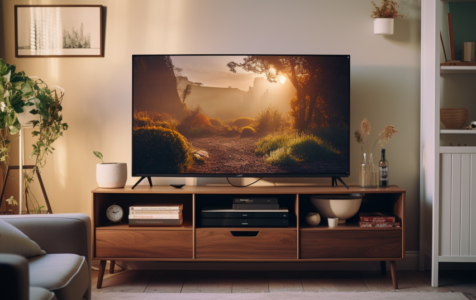This guide provides specific steps to connect your laptop to your Smart TV using four different methods: HDMI, Miracast, AirPlay, and Google Chromecast. It also includes cable considerations, how to change your display settings, and troubleshooting tips.
Connection Methods
HDMI Connection
Requirements:
- HDMI Cable
- HDMI ports on both laptop and TV
Procedure:
- Insert one end of the HDMI cable into your laptop’s HDMI port.
- Connect the other end to your TV’s HDMI port.
- Use your TV remote to select the correct HDMI input source.
HDMI cables are designed for high-resolution output and are reversible.
Miracast Wireless Connection
Requirements:
- Miracast-supported TV and laptop
- Both devices on the same Wi-Fi network
Procedure:
- Confirm both devices are on the same Wi-Fi network.
- Go to “Settings” on your laptop, then “Display,” and then “Multiple displays.”
- If your TV isn’t listed, click “Detect.”
Note: If Miracast is not supported, alternative devices like Roku can also be used for wireless streaming.
Wireless HDMI Adapter
This connects to your laptop’s HDMI port and wirelessly transmits both video and audio to your TV.
Microsoft Wireless Display Adapter
Similar to Google Chromecast, this device plugs into your TV’s HDMI port, allowing your laptop screen to be displayed wirelessly on your TV.
Note: Steps to establish these connections can differ based on the devices you have. For precise instructions, refer to the user manuals or support sites specific to your devices.
AirPlay Wireless Connection (For Apple Users)
Requirements:
- Apple TV or an AirPlay 2-enabled Smart TV
- Mac computer
- Both devices on the same Wi-Fi network
Procedure:
- Make sure both devices are on the same network.
- Click the Control Center icon in your Mac’s menu bar.
- Select “Screen Mirroring” and choose your TV.
Google Chromecast Connection
Requirements:
- Google Chromecast device
- Chromebook or any laptop with Google Chrome
- Both devices on the same Wi-Fi network
Procedure:
- Confirm both devices are on the same network.
- Open Chrome on your laptop.
- Click the three-dot menu icon, then “Cast.”
- Choose “Sources,” then “Cast desktop,” and select your TV.
Cable and Compatibility Considerations
HDMI Cable Types
- Standard HDMI: Supports 720p and 1080i.
- High-Speed HDMI: Suitable for 4K, FHD, UHD, and 3D.
- HDMI with Ethernet: Enables data transmission between internet-ready devices.
Cable Length
For an optimal connection, use an HDMI cable that doesn’t exceed 16 feet to avoid signal loss.
Changing Display Settings
For Windows Users
- Press ‘Windows key + P’ for quick settings access.
- Navigate: Action Center > Project > Choose setting.
For Mac Users
- Navigate: Apple Menu > System Preferences > Displays > Arrangement.
Troubleshooting Tips
- Verify the TV is on the correct input source.
- Double-check your laptop’s display settings.
Conclusion
This guide covers the steps to connect a laptop to a Smart TV using HDMI, Miracast, AirPlay, or Google Chromecast. It also advises on cable types and lengths, as well as how to adjust your display settings.
